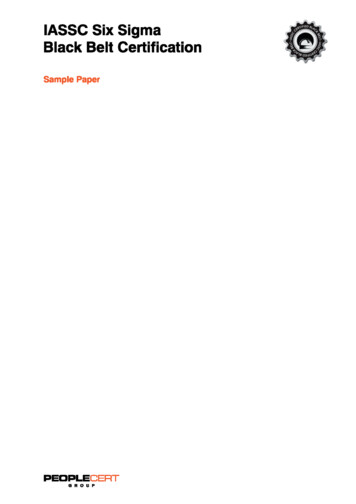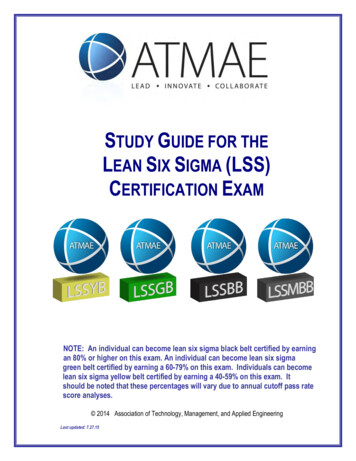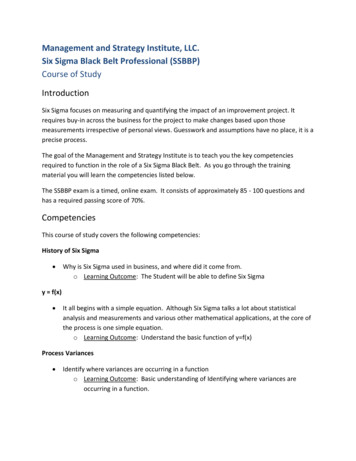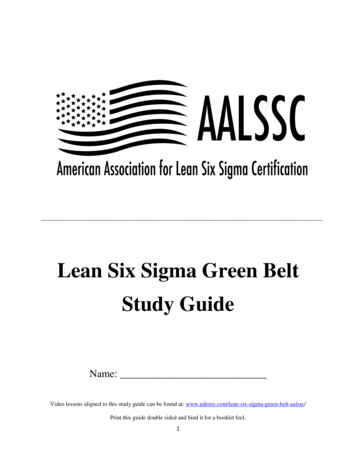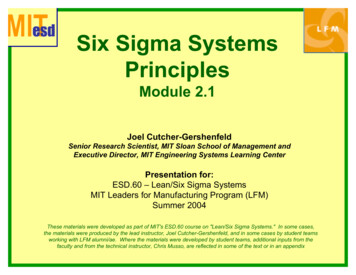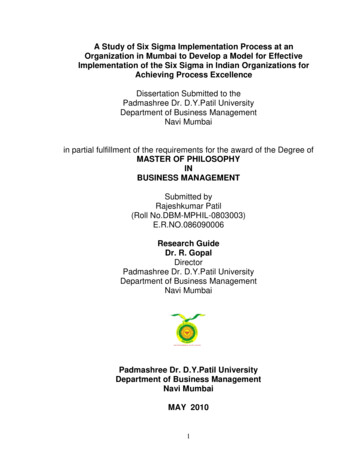
Transcription
A Study of Six Sigma Implementation Process at anOrganization in Mumbai to Develop a Model for EffectiveImplementation of the Six Sigma in Indian Organizations forAchieving Process ExcellenceDissertation Submitted to thePadmashree Dr. D.Y.Patil UniversityDepartment of Business ManagementNavi Mumbaiin partial fulfillment of the requirements for the award of the Degree ofMASTER OF PHILOSOPHYINBUSINESS MANAGEMENTSubmitted byRajeshkumar Patil(Roll No.DBM-MPHIL-0803003)E.R.NO.086090006Research GuideDr. R. GopalDirectorPadmashree Dr. D.Y.Patil UniversityDepartment of Business ManagementNavi MumbaiPadmashree Dr. D.Y.Patil UniversityDepartment of Business ManagementNavi MumbaiMAY 20101
A Study of Six Sigma Implementation Process at anOrganization in MumbaiTo Develop a Model for EffectiveImplementation of the Six Sigma in IndianOrganizations for Achieving Process Excellence2
DECLARATIONI hereby declare that the dissertation” A study of Six Sigma implementationprocess at an organization in Mumbai to develop a model for effectiveimplementation of the Six Sigma in Indian organizations for achieving ProcessExcellence“ submitted for the degree of Master of Philosophy (BusinessManagement ) at Padmashree Dr. D.Y.Patil University’s Department ofBusiness Management is my original work and the dissertation has notformed the basis for the award of any degree, associate ship, fellowship orany other similar titles.Place: Navi MumbaiDate:( Rajeshkumar Patil )Signature of the Student3
CERTIFICATEThis is to certify that the dissertation titled “A study of Six Sigmaimplementation process at an organization in Mumbai to develop a modelfor effective implementation of the Six Sigma in Indian organizations forachieving Process Excellence“ is a bona fide research work carried out by sinessManagement), at Padmashree Dr. D.Y.Patil University’s Department of BusinessManagement, during the period 2008-2010, in partial fulfillment of therequirements for the award of the Degree of ‘Master of Philosophy (BusinessManagement)’ and that the dissertation has not previously formed the basis forthe award of any other Degree, Diploma, Associate ship, fellowship or any othersimilar title.Place: Navi MumbaiDate:(Dr.R.Gopal)Signature of the Guide4
AcknowledgmentI take this opportunity to express my indebtedness to the PadmashreeDr.D.Y.Patil University’s Department of Business Management, which hasaccepted me for M. Phil. Program and provided an excellent opportunity to carryout the research project on Six Sigma. I sincerely thank Dr. R. Gopal, ouresteemed Director of Department of Business Management, PadmashreeDr.D.Y.Patil University for wholeheartedly supporting the endeavor by giving mehis valuable guidance for this research. I thank to Dr.Pradip Manjrekar, Professorfor his support during my M.Phil.I would also like to thank my family and colleagues, seniors of my organizationsand staff members of Department of Business management for their supportwhich helped me in completing the research work successfully.Place: Navi Mumbai(RAJESHKUMAR PATIL)Date:Signature of the Student5
TABLE OF CONTENTSChapter No.TitlePage No.AList of Tables10BList of Figures11CList of Abbreviations12DExecutive Summary141Introduction & Objective of Research171.1Objectives of this Research171.2Comparative study of various process excellence19initiatives1.3Process Excellence in India231.4TATA Business Excellence Model271.5CII-EXI M Bank Award for Business31Excellence1.6IMC RAMKRISHNA BAJAJ NATIONAL QUALITY33AWARD1.7An Introduction to Larsen & Toubro Limited-EAOC35Research Methodology572.1Research Problem572.2Type of Research572.3Research methods582.4Data Collection602.5Research Process6226
TABLE OF CONTENTS (Contd)Chapter No.TitlePage No.3Review of Literature633.1Literature Review633.2Key elements of successful six sigma66applications.3.3Obstacles and challenges of six sigma method683.4The Literature survey outcome:71An Introduction to Six Sigma Methodology724.1Definition of Six Sigma724.2The Six Sigma Strategy754.3DMAIC Methodology of Six Sigma764.4Design For Six Sigma774.5Basic differences between Six Sigma DFSS804and DMAIC methodologies4.6Design for Six Sigma Defined and Explained804.7LEAN approach of Process excellence814.8Six Sigma Organization854.9Six Sigma Project Cycle DMAIC90Six Sigma Implementation Model945Development & Application5.1An Approach context to Indian organizations945.2Organizational culture at L&T, C&A955.3Implementation Plan Development1065.4Pre ent1217
TABLE OF CONTENTS (Contd)Chapter No.TitlePage No.5.7Six Sigma Implementation Model1225.8Evolving a Six Sigma Project Implementation123model5.9Benefits of Model1275.10Validation of the model127Six Sigma Implementation Model Validation128Larsen & Toubro Electrical Business Group’s12866.1Implementation of Six Sigma6.2Result of the Six Sigma Implementation at L&T1336.3Case Study at Larsen & Toubro144Conclusions & Recommendations1577.1Research Findings1577.2Research Contribution1587.3Limitation of Research Findings1587.4Implication for future research1597.5Six Sigma Implementation Strategy for Indian1597organizationsReference Section1718.1Glossary1728.2Annexure180Annexure-I Six Sigma project data for various1808SBUsAnnexure-II Six Sigma Implementation ModelEffectiveness Analysis8188
TABLE OF CONTENTS (Contd)Chapter No.Title8.3Page No.Annexure-III Six Sigma ImplementationEffectiveness QuestionnaireAnnexure-IV Result of Six SigmaImplementation Effectiveness QuestionnaireAnnexure-V Six Sigma SBU wise analysis2008-09Annexure-VI Summary of customersatisfaction survey to assess Current state ofBusiness Process (2008)Annexure-VII Summary of customersatisfaction survey to assess state of BusinessProcess after Six Sigma implementation model(2010)Annexure-VIII Six Sigma ImplementationModel effectiveness analysis 2008-09Bibliography9189190192193198203205
List of TablesTable 1.1 History and description of various Process Excellence InitiativesTable 4.1 Probability of defects of different sigma levelsTable 5.1 Gender breakup at C&ATable.5.2 Age categorization at C&ATable 5.3 A comparison of Lean & Six SigmaTable 5.4 Lean Six Sigma Business Improvement Approaches.Table 6.1 Six Sigma Trained ResourcesTable 6.2 Internal Customer Satisfaction Survey (Respondent wise)Table 6.3 Result of Internal Customer Satisfaction SurveyTable 6.4 Line Manager’s Six Sigma Initiative Rating StatusTable 6.5 C&A Six Sigma Project status10
List of FiguresFig. 4.1 Research MethodologyFig.5.1 Maslow’s Hierarchy of NeedsFig.5.2 Six Sigma Implementation Model for Indian IndustriesFig. 5.3 Six Sigma Project Implementation ModelFig.6.1 No. of Six Sigma projectsFig.6.2 C&A Six Sigma Project trendFig. 6.3 Lean Six Sigma project charterFig. 6.4 Cause & Effect Diagram for the delay in GR postingFig.6.5 Project flow to improve GR posting Cycle TimeFig.6.6 Six Sigma project completion format11
LIST OF ABBREVATIONSL&TLarsen & Toubro LimitedC&AControl & AutomationEBGElectrical Business GroupEAOCElectrical &Automation OperatingSBUStrategic Business UnitGBGreen Belt (Six Sigma)BBBlack BeltMBBMaster Black BeltOMOperating ManagerPMProject ManagerLMLine managerCTMCore Team ingELITEEBG’s Lean initiatives towards ExcellenceVSMValue Stream mappingVAValue AddedNVANon Value AddedLTLead TimeMEDMedical SBUMPSMetering Protection system SBUESPElectrical Switchgear Products SBU12
ESEElectrical System & Equipments SBUFMEAFailure Mode Effect AnalysisQFDQuality Function Deployment13
Executive SummarySix Sigma is the one of the most powerful management tool used to achieveprocess excellence. It has been successful in many western companies, most ofthem are fortune 500 companies like GE, Motorola, Ford. As Jack Welch, ExCEO of GE said, “Six Sigma is the most important initiative GE has everundertaken. It is the part of the genetic code of our future leadership”, Six Sigmais now started becoming important & popular tool to remove variation & to reducedefects from product, process & service. All over world organizations areimplementing process excellence initiatives like Six Sigma toimprove process& product quality. History of these process initiatives shows that implementationof these initiatives is successful only in few organizations. A through analysis isrequired to study success & failure of implementation of these initiatives.Many organizations in India are also implementing Six Sigma to improveBusiness processes. But Geographical, Cultural & Work environmentaldifferences influences this implementation process. An implementation strategydeveloped for Indian work environment will increase effectiveness of Six Sigmain Indian Organizations. For this a Six Sigma Implementation model exclusivelydeveloped for Indian Organizations considering experiences of representativeorganizations is required. By using this model effectiveness of Six Sigmaimplementation in Indian Organizations will increase.The objective of this research is to develop a model for implementation of SixSigma in Indian organizations. In this study an emphasis is given on human14
angle in context with Indian Culture and work environment because experienceshows that for implementation of any new initiatives in organizations, the successof implementation depends on soft skills of people of organizations.This is an exploratory research. The research methodology incorporatedqualitative & quantitative research instruments. A comparison is done betweenvarious process excellence initiatives.An integrated methodology using the tools, techniques and skills from leanprinciples and Six Sigma is necessary to optimize business process. Leanfocuses on process speed, and Six Sigma focuses on process quality. Thiscombination is very useful for Indian organizations and used while developingImplementation model in this research.In this research following models developed.1. SIX SIGMA Implementation Model for Indian Industries2. SIX SIGMA Project Implementation modelValidation of the model is done by comparing internal customer satisfactionsurvey before and after implementing model. Extensive data is gathered for thisand analyzed. A detail case study from representative organization is taken tovalidate Six Sigma project Implementation model.Best of the both lean and Six Sigma methodology is used while developing thesemodels. These models can be effectively used to reduce cycle time of businessprocess. Customer satisfaction can be achieved along with business benefit byusing these models.Various Six Sigma tools to be used along with this model are also discussed.15
The Six Sigma Implementation model used to evaluate readiness oforganizations interms of commitment ofmanagement, awareness &methodology. It also evaluates cultural aspects which is more important to Indianwork environment.The model guides for step by step implementation process. It also helps informulating Implementation strategy and selecting tools & methodology. Creatinginternal resource base is most important for any organization. The pool of Backand Green belts carry on Six Sigma revolution, in an organization after consultantrole is over. After developing implementation model a model for successful SixSigma projects developed.The implementation of Six Sigma will be more effective if Indian organizationsuse these models.16
Chapter 1Introduction & Objective of ResearchAll over the world many companies are adopting Six Sigma methodology asprocess excellence tool. GE, Motorola, ABB, Citi Bank, Ford are few of them.Some Asian companies are also have been implemented Six Sigma. Toshiba,Honda, Sony and Samsung are few of them.In India many companies are implementing Six Sigma. Tata motors, Larsen &Toubro, HDFC are few of them. Globalization has opened the doors of worldmarket to Indian organizations, which in turn forcing them to bring their products& services to world class level. For that along with various tools Six Sigma isbecoming popular in India. Indian Statistical Institute is doing good work topromote Six Sigma in India.However due to cultural, work environment & economical differences betweenIndia & western countries, different implementation strategy is required for India.To evolve this strategy & model for implementation, a through study of Indianwork & organizational environment in Indian industries is required.1.1 Objectives of this Research:Considering specific need of Indian companies to implement Six Sigmaeffectively, this research is to study the problem.17
The main objectives of the research are as follows:1. To understand the need of Six Sigma in an Organization2. To develop a model for effective implementation of Six Sigma in IndianOrganization3. To develop a model for successful Six Sigma projects in IndianOrganizationsTo do research on this topic a representative Indian organization is to beselected and in depth study spread in to sufficient time period should beconducted.The study is carried out in Larsen & Toubro Limited as it is an Ideal IndianOrganization.Also researcher is having access to the data and close monitoring of Six Sigmaimplementation process could be done.18
1.2 Comparative study of various process excellence initiativesHistory and description of various Process Excellence eTime Frame1979-1984StatisticalProcessControl (SPC)1923(beingpracticed inIndia from 1980till date)QualityManagementFrom 1987 tilldateBrief DescriptionImplementingOrganizationQuality improvement orIn JapaneseImprovement activitiescontext, most of theby small groups,visitors to JUSEcomposed of a smallwere shown thenumber of employeesworking of Quality(10 or few).QualityControl Circles. InCircles Structure and the Indian context,working conceptsBHEL under theoriginated in Japanleadership of Mr.Udupaimplemented the
11.07.2015 · 2. SIX SIGMA Project Implementation model Validation of the model is done by comparing internal customer satisfaction survey before and after implementing model. Extensive data is gathered for this and analyzed. A detail case study from representative organization is taken to validate Six Sigma project Implementation model.


